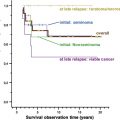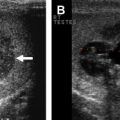Brain metastases occur in approximately 10% of patients with advanced metastatic germ cell tumors. Patients with nonseminomatous histology, lung metastases, and high β-human chorionic gonadotropin levels are at higher risk for synchronous brain metastases at first diagnosis and for relapsing with brain metastases after successful cisplatin-based chemotherapy. Patients with brain metastases should undergo multimodal treatment strategies, including cisplatin-based combination chemotherapy plus radiotherapy or surgery. However, the optimal combination and sequence of these strategies remain unclear and may differ between subgroups. But in all cases, chemotherapy must be part of treatment, even in patients with isolated cerebral relapse without systemic disease.
Brain metastases are rare in germ cell tumors, occurring in fewer than 1% of all patients and in approximately 10% of patients with advanced metastatic disease. Patients presenting with cerebral metastases are classified as “poor prognosis” according to the International Germ Cell Consensus classification (IGCCCG). The overall survival of this risk category is only approximately 50%, in contrast to the high rates of long-term survival of 80% to 90% in patients without metastases to organs other than the lungs. In patients with primary brain metastases, the prognosis may even be worse, with only 30% to 35% of patients achieving long-term survival compared with the overall group of “poor risk” patients.
Single cases of patients with brain metastases who had experienced long-term survival after combined modality treatment were reported in the early 1980s, but large systematic analyses or prospectively conducted trials on the optimal management of adult patients with brain metastases of germ cell tumors, including chemotherapy, radiotherapy, and surgery, are still lacking. Today, treatment recommendations for adult patients with cerebral metastases of germ cell tumors are mainly based on retrospective case series, subanalyses of clinical studies, and expert opinion.
Characteristics of patients with cerebral metastases at first diagnosis of metastatic disease
One of the first case series of patients with brain metastases from germ cell cancer reported the presence of synchronous lung metastases in each of the 10 reported patients and β-human chorionic gonadotropin (β-HCG) higher than 40,000 U/L in 70% of patients. Further cohort studies repeatedly showed synchronous lung metastases in 90% to 100% of patients with brain metastases and extremely elevated serum levels of β-HCG in 50% to 90% of those patients. Of patients with brain metastases, 30% to 90% present with additional metastases to other organs. No cases with isolated cerebral metastases at primary diagnosis without evidence of metastases in other locations have been reported so far. The primary site of germ cell cancer in patients with brain metastases at first diagnosis was extragonadal in 15% to 20%, a relatively high proportion. The histology was nonseminoma in 90% to 99% of cases. Pure seminoma is rarely found in patients with brain metastasis. Nonseminomatous histologies were mainly malignant teratoma in 20% to 50%, embryonal carcinoma in 20% to 30%, and choriocarcinoma in 15% to 30%. Chorioncarcinoma has been reported to be associated with a particularly poor prognosis independent of the treatment strategy. However, multivariable analysis of the IGCCCG had not shown a prognostic impact of different nonseminomatous histology subtypes in general.
In the previously reported series, patients with brain metastases at primary diagnosis presented with single brain metastases in 40% to 50% and without neurologic symptoms in 40% to 70%. Metastases were frequently diagnosed through extended upfront staging investigations. Two analyses have shown a significantly better prognosis for patients with a single brain metastasis. Among 56 patients with brain involvement at first detection of metastatic disease, 2-year survival was 76% for those with a single brain lesion versus 38% for those with multiple brain tumors ( P = .023). In a second study of 44 patients with brain metastases discovered either at initial diagnosis or at relapse after chemotherapy, those with a single brain lesion had a higher overall survival (44% vs 9%; P <.02).
Brain metastases in relapsed germ cell tumors
Relapses with isolated brain metastases within a few months after successful completion of platinum-based chemotherapy for metastatic germ cell cancer have been reported in 13 patients from four case reports in the 1990s, resulting in a frequency of 0.1% to 2%. These cases have suggested a correlation between the presence of primary lung metastases and nonseminomatous histology, mainly embryonal carcinoma, with the occurrence of an isolated cerebral relapse after chemotherapy. However, two cases with pure seminomatous histology and isolated cerebral relapse have also been reported.
In 2007, Azar and colleagues presented a series of five patients with isolated cerebral relapse after initial cisplatin-based chemotherapy who all had components of embryonal carcinoma and pulmonary metastases at primary diagnoses. The investigators discussed an incomplete penetration of cytostatic drugs through the blood–brain barrier as the reason for isolated cerebral relapse after chemotherapy.
In this article’s authors’ own analysis of patients experiencing relapse with brain metastases after primary high-dose chemotherapy, all 13 patients with isolated cerebral relapse had initially presented with lung metastases and highly elevated β-HCG levels. In addition, all patients with cerebral plus systemic relapse had presented with primary lung metastases and highly elevated β-HCG levels at initial diagnosis. In total, cerebral metastases have been detected in 25% of the whole cohort of “poor prognosis” patients who had relapsed after primary high-dose chemotherapy.
In contrast to other locations, where de novo metastases at relapse had occurred in only 6% to 16%, 73% of patients relapsing with brain metastases had no evidence of cerebral metastases before chemotherapy. The high rate of patients with cerebral relapse after high-dose chemotherapy is in marked contrast to publications on conventional-dose chemotherapy postulating an incidence of only 2% for all metastatic stages. This finding could either be attributed to a different tumor biology in patients with advanced metastatic disease or more likely to an increased extracerebral efficacy of high-dose chemotherapy in a “poor risk” population while the effect of chemotherapy in the cerebrum still remains limited.
Comparing the prognosis of patients presenting with brain metastases at primary diagnosis to those developing brain metastases during or shortly after adequate cisplatin-based chemotherapy, the latter patients have considerably worse outcomes. In one analysis of a cohort of patients with brain metastases, the occurrence of brain metastases at initial diagnoses was a statistically significant positive prognostic factor among patients presenting with brain metastases at any point during their disease. The proportion surviving at least 2 years was 33% in patients with brain metastases at initial diagnosis compared with 5% in those who developed brain metastases during or after first-line chemotherapy. Other studies indicated 2-year or longer survival rates of approximately 30% to 50% in patients with primary brain metastases and 10% to 30% in those with brain metastases at first relapse.
Brain metastases in relapsed germ cell tumors
Relapses with isolated brain metastases within a few months after successful completion of platinum-based chemotherapy for metastatic germ cell cancer have been reported in 13 patients from four case reports in the 1990s, resulting in a frequency of 0.1% to 2%. These cases have suggested a correlation between the presence of primary lung metastases and nonseminomatous histology, mainly embryonal carcinoma, with the occurrence of an isolated cerebral relapse after chemotherapy. However, two cases with pure seminomatous histology and isolated cerebral relapse have also been reported.
In 2007, Azar and colleagues presented a series of five patients with isolated cerebral relapse after initial cisplatin-based chemotherapy who all had components of embryonal carcinoma and pulmonary metastases at primary diagnoses. The investigators discussed an incomplete penetration of cytostatic drugs through the blood–brain barrier as the reason for isolated cerebral relapse after chemotherapy.
In this article’s authors’ own analysis of patients experiencing relapse with brain metastases after primary high-dose chemotherapy, all 13 patients with isolated cerebral relapse had initially presented with lung metastases and highly elevated β-HCG levels. In addition, all patients with cerebral plus systemic relapse had presented with primary lung metastases and highly elevated β-HCG levels at initial diagnosis. In total, cerebral metastases have been detected in 25% of the whole cohort of “poor prognosis” patients who had relapsed after primary high-dose chemotherapy.
In contrast to other locations, where de novo metastases at relapse had occurred in only 6% to 16%, 73% of patients relapsing with brain metastases had no evidence of cerebral metastases before chemotherapy. The high rate of patients with cerebral relapse after high-dose chemotherapy is in marked contrast to publications on conventional-dose chemotherapy postulating an incidence of only 2% for all metastatic stages. This finding could either be attributed to a different tumor biology in patients with advanced metastatic disease or more likely to an increased extracerebral efficacy of high-dose chemotherapy in a “poor risk” population while the effect of chemotherapy in the cerebrum still remains limited.
Comparing the prognosis of patients presenting with brain metastases at primary diagnosis to those developing brain metastases during or shortly after adequate cisplatin-based chemotherapy, the latter patients have considerably worse outcomes. In one analysis of a cohort of patients with brain metastases, the occurrence of brain metastases at initial diagnoses was a statistically significant positive prognostic factor among patients presenting with brain metastases at any point during their disease. The proportion surviving at least 2 years was 33% in patients with brain metastases at initial diagnosis compared with 5% in those who developed brain metastases during or after first-line chemotherapy. Other studies indicated 2-year or longer survival rates of approximately 30% to 50% in patients with primary brain metastases and 10% to 30% in those with brain metastases at first relapse.
Prognostic impact of brain metastases
Patients presenting with nonpulmonary visceral metastases at initial diagnosis are classified as poor-risk patients according to IGCCCG. Within this poor-risk group, patients with brain metastases have the poorest 5-year survival rate (33%) in the multivariate analysis of the IGCCCG compared with 35% for those with bone metastases and 49% for those with liver metastases. This finding is strengthened by an explorative analysis of prognostic subgroups within the poor-risk patients, showing that nonabdominal, nonpulmonary organ metastases, which mainly represent brain and bone involvement, are associated with an especially poor prognosis, with a 2-year progression-free survival rate of only 36%. In another study analyzing prognostic factors in patients with extragonadal germ cell tumors, brain metastases only occurred in patients with nonseminomatous histology and were correlated with an inferior prognosis in multivariate analysis, with 5-year overall survival rates of 25% compared with 53% in patients without brain metastases.
In previous prognostic models for patients experiencing progression or relapse after cisplatin-based chemotherapy, brain metastases did not have a prognostic impact on patient survival. A recent analysis of the International Prognostic Factors Study Group, including approximately 2000 patients after failure of cisplatin-based chemotherapy, showed that the presence of liver, bone, or brain metastases represent relevant prognostic factors in addition to the location of primary tumor, the response to prior chemotherapy, and tumor marker levels.
Diagnostic procedures for detection of brain metastases
Clinical data on the optimal diagnostic strategies for detection of brain metastases are rare and prospective trials on the impact of diagnostic procedures are missing. Today, international consensus guidelines on diagnostics in patients with germ cell tumors recommend CT scans of the cerebrum only in patients with advanced metastatic disease or neurologic symptoms at primary diagnosis. Taking into account the earlier-outlined analyses on characteristics of patients with brain metastases, CT or MRI scans of the brain are especially indicated in patients presenting with pulmonary metastases and highly elevated β-HCG levels at primary diagnosis, irrespective of the presence of neurologic symptoms. No standardized recommendation for diagnostic procedures in patients experiencing relapse after cisplatin-based chemotherapy have been defined so far, but according to the limited number of retrospective analyses presented earlier, CT scan might be indicated in patients relapsing with pulmonary metastases and high β-HCG levels, especially after primary high-dose chemotherapy. In patients with lung metastases at primary diagnosis and a histology of embryonal carcinoma, clinicians should be aware of the risk of an isolated cerebral relapse after successful cisplatin-based chemotherapy, and CT scans should be performed immediately at the first appearance of neurologic symptoms. Another indication may be the search for the relapse site in patients with elevated tumor markers and no sign of peripheral metastases.
Stay updated, free articles. Join our Telegram channel

Full access? Get Clinical Tree






